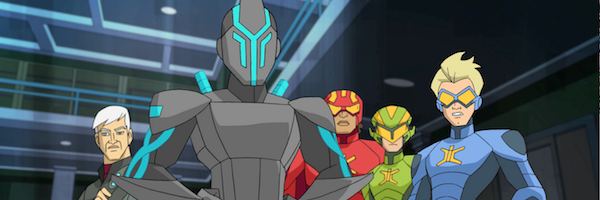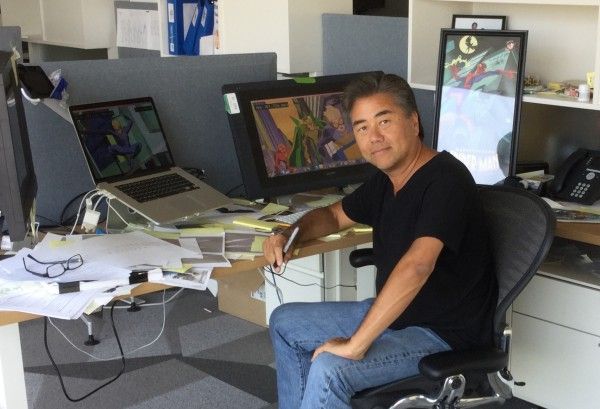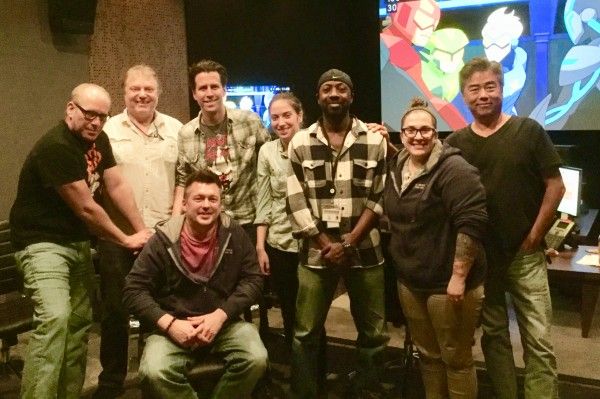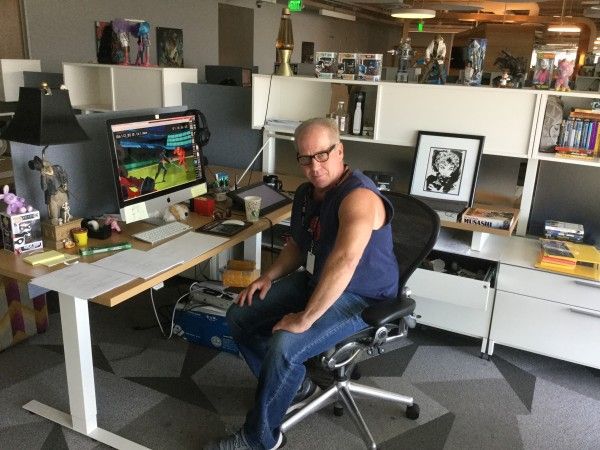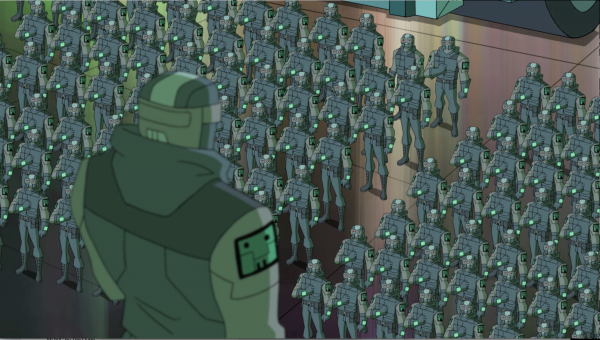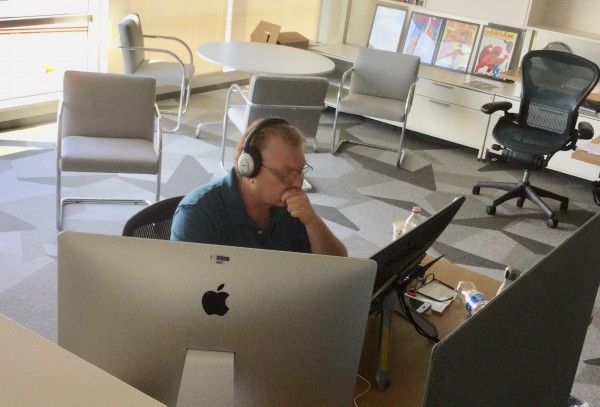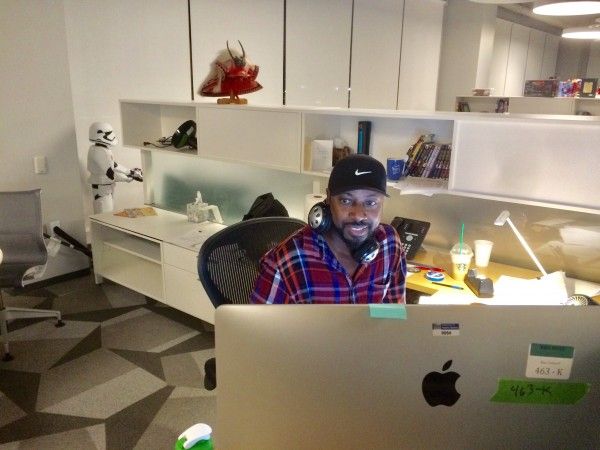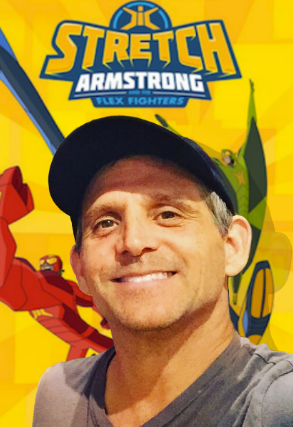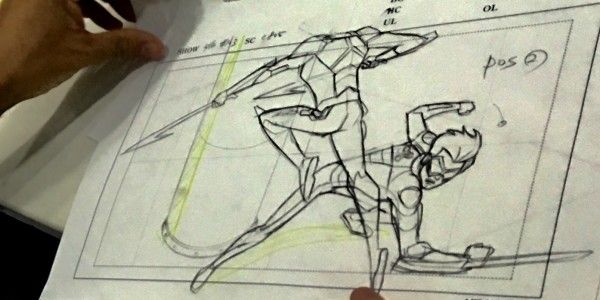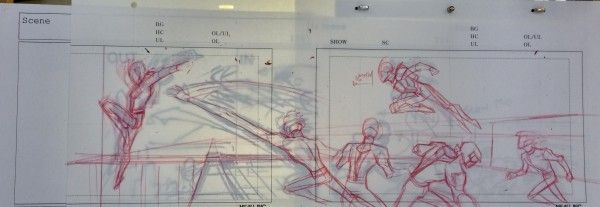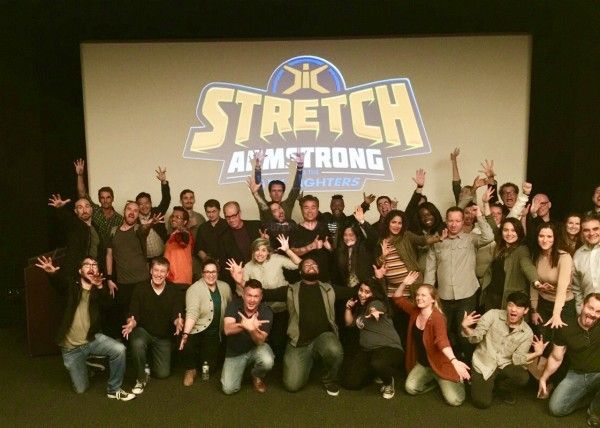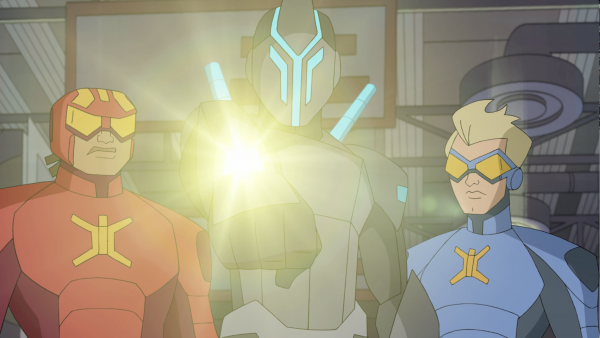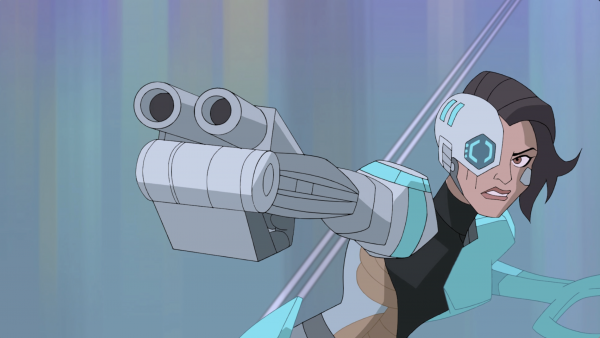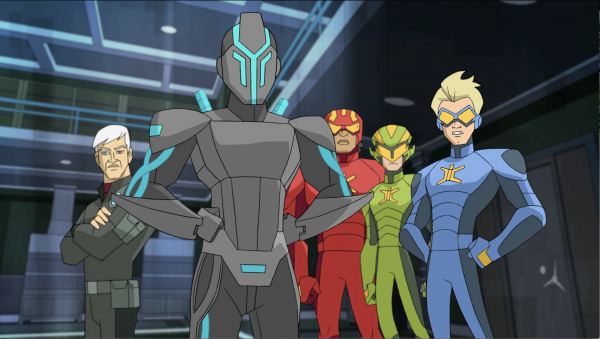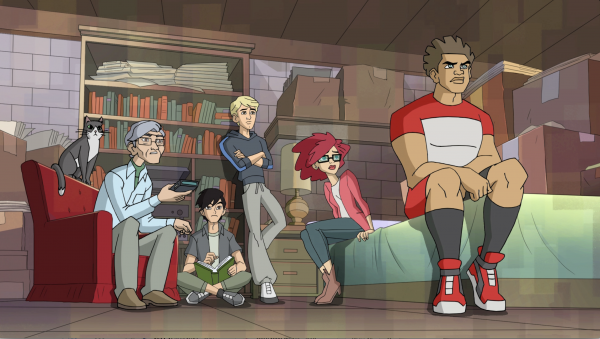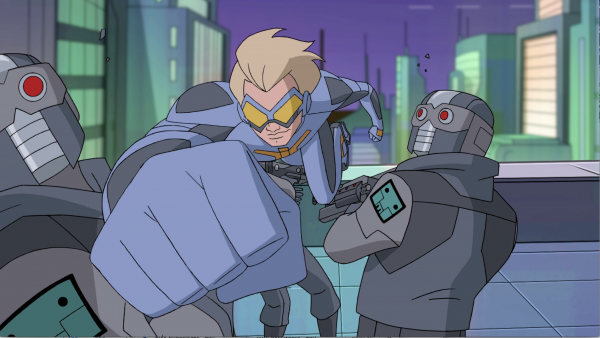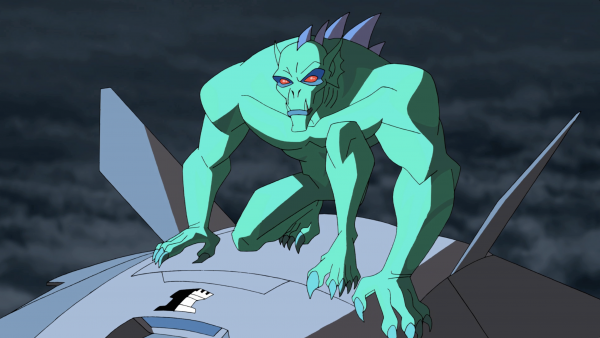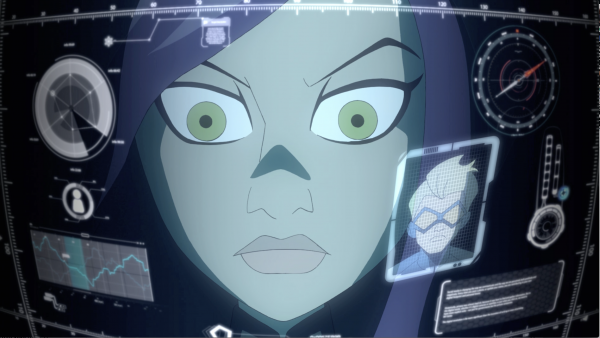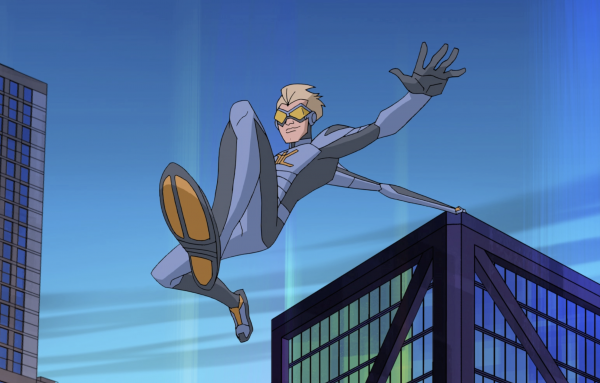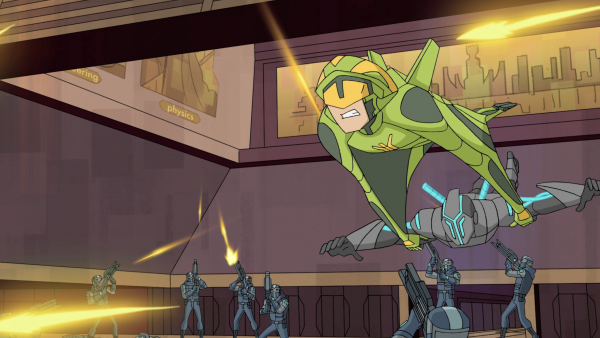Spoilers ahead if you aren't caught up with Season 1 of Stretch Armstrong and the Flex Fighters, and the interactive special, only on Netflix.
In this modern era of superhero stories in comic books, TV shows, and feature films, to stand out, you have to be flexible, and it helps to be colorful. Those are the major factors at play in the original animated superhero series Stretch Armstrong and the Flex Fighters, a rebranding of the classic and iconic Hasbro toy that has not only launched wholly unique characters but also a mythology that's all their own. Ahead of the super-stretchy series' highly anticipated return to Netflix with all new episodes this Friday, September 7th, we had a chance to chat with executive producer Victor Cook (The Spectacular Spider-Man) and his team of directors to look back at Season 1 and tease what's ahead for the Flex Fighters in Season 2.
The directing team is comprised of industry veterans like Cook himself, along with Kevin Altieri (Batman: The Animated Series), Frank Paur (Gargoyles), Alan Caldwell (Jackie Chan Adventures), and Phil Weinstein (Hellboy Animated: Sword of Storms). The creative team, all of whom have worked on adaptations of some of comic book history's most famous creations, talked about getting a chance to direct stories for original superheroes in a modern world, along with which of these stories were the most challenging and which they were most proud of. New and returning fans of Stretch Armstrong alike will want to pay close attention to the teasers and images scattered throughout, while anyone with an interest in animation will find a wealth of information here.
Be sure add Season 2 of Stretch Armstrong and the Flex Fighters to your wish-list and tune in on September 7th to see the original title team's ongoing adventures!
Vic, you're listed as both an Executive Producer and a Supervising Director on Stretch Armstrong. How do those duties differ and where do they cross over, if at all?
Victor Cook: My Executive Producer duties cover big-picture, overall series guidance. From creative world-building of characters, story and tone, to decisions about casting, music, choosing animation studios, locking picture and delivering final audio mixed episodes. In this role I work with my fellow EPs, the art/production crew, the studio and the network execs.
As a Supervising Director, my job is focused on the film making, the staging, poses, timing and choreography as well as the lighting, mood and design. I also guide how it will all move in animation. I edit and call retakes. In this role I work closely with the Episode Directors, Storyboard Artists, Art Director and designers as well as the animation studios in Korea. The cross-over duties for both my titles are the visuals aspects.
Season 1 of Stretch had to do the heavy lifting of introducing the series' characters, their story, and their world. What Season 1 achievements are you particularly proud of and how will you build on them in Season 2?
Cook: I am proud of it all! Jake, Nathan and Ricardo's world got turned upside down, what they believed about certain friends and certain enemies turned out to be untrue and flipped. I am particularly proud of the reveal that Blindstrike was not a bad guy and not even a guy at all, but the girl Jake has a crush on, Riya Dashti. Rook turning out to be Stretch Monster was another season one twist which ended The Flex Fighters run as corporate superheroes. Rook has caused most of Charter City to turn against Stretch, Omni-Mass and Wingspan.
Season Two will see The Flex Fighters deal with their new reality as heroes gone rogue. Stretch, Omni-Mass and Wingspan go underground and team up with Dr. C and Blindstrike and have to adapt to their harsher, darker methods of fighting crime. Riya Dashti/Blindstrike is a badass, strong female character and she is even more important in season two and we will learn what drives her and delve into her back story. In season one, we were introduced to Jake, Ricardo and Nathan, but in season two we go deeper and get to know them better, their inner demons and Jake's tragic past. Characters we thought we knew in season one, like Rook, Riya and Dr. C are explored in detail in season two, we'll find out why they are so obsessive about their goals and what set them on their paths. Stretch Monster is still a danger to contend with. New Super-Villains arrive to threaten the city and The Tech Men return with their own insidious agenda as well as more advanced hi-tech, mechanical weapons. The Flex Fighters fight to save a city that doesn't trust them and the story progresses deeper and darker to a massive threat of sheer evil. Season two is thrill ride of fantastic action scenes and edge of your seat story twists and turns.
You've assembled a fantastic group of directors for Season 1 and Season 2. What can you say about the level of experience they brought into Season 1 and how they've grown or changed for Season 2?
Cook: I have worked with these amazing Director-artists before on other projects. It was fantastic to have their experience and talent on this show.
In Season 1, Kevin Altieri and Frank Paur Directed four episodes each. Alan Caldwell started the series as a storyboard artist and then moved up to Direct an episode. Phi Weinstein guest directed one episode.
Kevin Altieri was a director on the legendary Batman: The Animated Series as well as many other shows such as The Spectacular Spider-Man and Transformers Rescue Bots. That level of experienced is definitely a benefit for Stretch Armstrong and the Flex Fighters. Kevin directed Episodes 3, 6, 9 and 12 of Stretch and he added a special touch to each of them, looking for ways to flesh out character and add mood. Kevin also ups the visuals for every action sequence, adding to every battle a level of intensity that is also character driven.
Frank Paur, is well known as a Producer of Disney's Gargoyles, and has directed many animated projects including Avengers Earth's Mightiest Heroes and The Invincible Iron Man. Frank directed Episodes 4, 7, 10 and 13. Frank's early experience as a layout artist helped give the environments in his episodes a real dimensional feel and he helped establish the look of Stretch and the team's hangout, Flex Base One. Frank's cinematic approach to directing also brought a heightened level of suspense to each of his episodes.
Alan Caldwell has directed on many series such as Jackie Chan Adventures and MTV Spider-Man. Alan started this show as a board artist and storyboarded the Blindstrike vs Stretch fight on the train in Episode 3. That sequence got him promoted to director on Episode 11, which featured a climatic battle with Blindstrike, Stretch Monster and the Flex Fighters. Alan's cinematic staging, precise character posing and choreography of action scenes are super exciting.
Phil Weinstein is known as a director of one of the Hellboy Animated DVDs as well as other DVD movies and many Disney TV series. Phil guest Directed Episode 5 of Stretch, which was a challenge since it had so many firsts, it introduced The Freak Sisters, the creepy-crawly bots called Stretchipedes and featured The Flex Fighter's first battle with Stretch Monster. Phil's experience Directing DVD movies as well as series, helped him do this as a one off for him. Phil researched the show, studied the characters and stepped in and delivered.
The interactive special, Stretch Armstrong and the Flex Fighters: The Breakout, featured sequences directed by Kevin, Frank and Alan. Kevin and Frank handled the villains that appeared in the season one episodes they directed. Alan directed three very cool sequences, Blind Strike and the Flex Fighters vs Stretch Monster, the battle with Kane and Rook Security and the climatic battle vs two villains
In Season 2, Alan directed four episodes, including the season premiere and season finale. Kevin and Frank directed three episodes each.
For everyone, which episode or sequence proved most challenging in Season 1? Which episode or sequence are you most proud of?
Cook: As a Supervising Director, overseeing each episode while juggling my duties as an EP was a constant challenge of not enough hours in the day. However, early in development, the most challenging but fun thing I directed was a 5 minute action short showing Stretch in various chase and fight scenarios. I made it to test out ideas and choreography for how Stretch's powers would work and it was to be used as reference for the storyboard team. I directed the short to follow Stretch linearly from one sequence to another against a small army of hi-tech militaristic thieves. We liked it so much, we didn't want it to be just reference for the board artists, so we found a way to insert it into an episode, you will see it in Season 2. Also, trivia FYI: The hi-tech thieves in the short inspired the creation of the Tech Men.
Of the three episodes I personally directed, I am most happy how Episode 8 turned out. An exciting return encounter and battle with Blindstrike vs our heroes. The board artists brought a lot to it. It was almost all visuals and action. An exciting infiltration opening and not one but two intense fight sequences. Even though this had the least dialogue, it had a great emotional story between Jake and his dad, which was very well staged. The city backgrounds looked great which was our usual setting, but this was a rare episode that also had a natural setting on an island with foliage which was beautifully painted. This episode was very well animated and the the character models and the background painting was closest to our intentions.
Kevin Altieri: Episode 6, "The Gangs of Old Town", because it started with the trial of mob boss, Jack Kinland and court room scenes are difficult to stage and make interesting. Jack is soon transformed into the super-villian Smoke Stack. Smoke Stack is one of my favorite characters, because I like the fact that this gangster stays dapper even after he turns into a rock monster. Plus I love how his powers could switch from rock hard to smoke, it was fun to choreograph the fight scenes and come up with interesting ways for him to use his powers. Staging the multi-gang fight at the end was also challenging because there were so many gang members that specialized in different fighting methods. I had fun keeping track of everyone and making the fight exciting and making sure that it all worked.
I'm most proud of the Blindstrike introduction in Episode 3, " Ninja and the Ghost." I feel the train sequence came out well. I am also fond of the cat in Episode 12, "Endgame". Although leaving the cat alone at the end wasn't in the script, I added that because it gives the right note of sympathy at the end of that episode.
Phil Weinstein: Trick question , I only worked on Episode 5!
Frank Paur: In every series that you work on, there is always “that one episode.” In the production of “Stretch Armstrong”, for me, that would have been Episode 10, or as I referred to it; that cursed Episode 10, the museum show.
Noted for its many crowd scenes and intricate detail, Episode 10 centered around a school outing to the city’s museum, one of the rooms contained a robot exhibit, featuring many different types of robotic machines, a centered atrium containing among other things a spiral ramp where much of the action would happen. And many types of equipment including a dinosaur and experimental space plane. Also included was another wing of the museum containing the McGuffin of the story.
The issues that this type of story creates are problematic: Keeping track of all the places and Its many characters, keeping an energetic and steady flow of action moving smoothly along, and keeping the audience attentive to the story, with a full understanding of how that story unfolds. It’s all very complicated. It feels at times that only spit, Band-Aids and gum are the only things keeping all the pieces together.
Alan Caldwell: "Secret Ninja Party" had me on creative rollercoaster. We had to come up with sequences that were true to the script, but were also visually unique. Thankfully I was blessed with fantastic board artists that made my job a bit easier. But it was the final animation on that episode that blew me away. Every now and then you get a show that comes incredibly close to what you'd imagined in your head. Episode 11 was that show.
You all had a chance to direct episodes for the regular season as well as for the interactive episode; how did those experiences compare? (Readers can also get more insight on the interactive special by checking out our chat with the episode's creative team here!)
Cook: Directing episodes was more of a linear experience. Directing the Interactive was more about treating each sequence like a puzzle piece that sometimes wasn't needed but still could be moved around and still be connective.
Altieri: The interactive was difficult to track because I was dealing with sequences as opposed to an entire script when I direct an episode.
Paur: Vic had a more direct hand in the interactive episode than in the regular shows. Because of the complexity and the logistics of this episode, the producer was the only one that held all the magic pieces that showed how everything fit together. so, it needed more of his direct input.
Caldwell: Having never directed an Interactive episode, I found that I had to think multiple ways at once. Keeping track of locations and where certain characters were, and even which direction they would take, was key to the the success of the episode.
Having worked on adaptations of iconic comic book properties like 'Spider-Man', 'Batman', and 'Avengers', how did those experiences compare to directing all-new, original superhero creations that the world had never seen before?
Cook: When I helped develop The Spectacular Spider-Man, we had years of history of that character to work with and stayed true the core of that character in our interpretation. Because Stretch was a nostalgic novelty toy and not a character with any previous story lines, we were free to create something totally brand new. We could interpret the stretching powers how we wanted. We could introduce a new rogues gallery with unique powers. We could feature a diversity of humanity that reflects real life, because we were able to create new characters from scratch to be any ethnicity or gender we wanted.
Altieri: The thing about Batman: The Animated Series and The Spectacular Spider-Man is, as a fan-boy I showed up with pre-conceived notions of what I wanted to do. Batman was something I wanted to work on my whole life. Realizing Ra's al Ghul for animation was a life-long dream. Where as Stretch Armstrong kind of came out of nowhere. Having no pre-conceived notions of the characters in Stretch made it fun for me to watch Jake and Erica and the other characters evolve and be a part of help making it happen.
Weinstein: For Stretch, I relied on Vic and his team to relay their vision for the show. They created the world and set the tone for the series. Getting a feel for the characters was something that evolved as the character business (how the characters performed) within the boards was created then tweaked. By contrast, on Hellboy Animated, there was lots of material from Mike Mignola and Guillermo del Toro's Hellboy films to understand the tone from the get go. It was our job to then do our take on that world.
Paur: As for comparisons for [shows like X-Men and other Marvel properties] to Stretch, to me, every show develops its own personality as you develop it. When you go from a printed medium to an animated one, things change. So, in a sense, any time you adapt something from on format to another, you are reinventing it.
What makes Stretch different, is that there was never an original story to act as a foundation. What Vic and his creative team had to do was create an entire universe from scratch. That means it has its own contained history, and logic. In a way it frees you up a lot more. You don’t have all the baggage that goes around with a known property. Also, fans don’t scream for your blood when you change a Cajun to a Goth.
Caldwell: When you work on well-known characters as the ones you stated, you already have a set of "rules" you must follow regarding them. Sure you can push the boundaries but you have to stay true to the source material.
But when you have a chance to create and add to an entirely new universe, that's where the fun is. I don't think a day went by that I wasn't bugging Vic with some new idea that I had.
Big question here, but what has been the biggest change in the TV animation industry you've seen over the years? It can be in terms of production, technology, storytelling, etc.
Cook: Technology. It's all digital now. We used to draw on paper, now we draw on a monitor screen, on a Cintiq. Although it's not on paper anymore, what hasn't changed is the fact that storyboards are still hand drawn. The thinking, talent and drawing ability it takes to storyboard hasn't changed.
Altieri: The thing missing now that we did on Batman was doing the production layouts here, as opposed to sending that part of the work overseas. Doing the layouts here gave us artistic taste control. Doing the layouts here on Batman meant we had a level of control that could survive even bad animation. Also back then, the talent pool back was greater, now it is very difficult to find people with the proper training.
Weinstein: When I began in the industry most background painters were still painting with acrylic paints, a few were just beginning to experiment in Photoshop. Storyboards were all done on paper and animation was shot on film, then transferred to videotape for editing. Now most studios use Storyboard Pro, Photoshop, and a full digital pipeline from footage thru editorial. Technology has sped up so many of the tasks of creating a show, but the underlying approach to telling a story in animation: from script to story sketches hasn't changed at all.
Paur: Digital technology. The things that we are able to do due to the new tech is pretty much amazing, Toon-Boom, Ink and Paint, Editing, CGI, camera work, just about every facet of animation has been set higher because of the new tech.
It’s interesting, when CGI was first being introduced into animation on an affordable budget, I used to push for its use all the time. It got me into huge trouble with the ruling executives at the studio I was with at the time. (That and pencils. But that’s a story for another time.) Studio managers just didn’t want to move beyond their comfort zone back then. Now no one can get along without it.
Caldwell: Technology has come a long way with the advent of Storyboard Pro. I remember the days when we used to cut out Post-its and tape them down to the board in order to change a pose.
Is there anything you particularly miss from your early years in animation?
Cook: I miss music being performed by a live orchestra for TV cartoons. In the first two animated TV shows I directed in the late 1990s, the music was written by a composer in about a week or two, then he would conduct around 8 or 12 or 24 live musicians. It was amazing, the musicians didn't see the sheet music until a minute before they played it. By the time I was directing Lilo and Stitch the series, the composers made almost all the music for TV cartoons with synthesizers, not an orchestra. I always wondered what ever happened to all those wonderful musicians.
Altieri: I had more hair back then.
Weinstein: It was very tactile. Lots of pencils, erasers and trips to the Xerox machine when things needed changing. When I first started in the industry there was a storyboard artist I admired who used a particular brand of pencil called an Ebony. I thought if I could just get my hands on one of those pencils I could draw as well as him. Of course when I finally got the Ebony pencil it didn't make my drawings any better. But I'm a bit nostalgic for those days when I believed certain pencils held magical drawing powers!
Paur: Friends who are no longer here.
Caldwell: I miss the "newness" I felt. New job, new people, new things to learn. I was a sponge with blinders on and a smile on my face.
Kevin and Frank, you both got to direct episodes that introduced villains in Season 1; how did you go about crafting their scenes to give them a signature style and make them stand out as unique?
Altieri: With Smoke Stack it was fun giving him his style. I love a giant rock guy who likes Cadillac convertibles and Italian suits. I feel my greatest contribution was the introduction of Madame Tousant and her gang, the Sables. They were some of my favorite Joey Mason character designs. They were a pleasure to draw. And Vanessa Marshall gave a great vocal performance as Madam Tousant.
Paur: For me, it’s about the visuals, those then can change dramatically when you enter the actor’s performance. Sound allows you to define the personality of your character, adding nuances to look and attitude that becomes familiar to everyone as the creation takes shape.
With Quick-Charge we created the character so that we could capitalize on her powers. She moved on lightning. So, we combined figure skating, racing and parkour into all of her moves as she moved from one area to another with a little ballet mixed in for good measure. She required a lot of choreography in animating her movements. Two to three times the amount of drawings we would normally us to bring in the nuances to her look and power.
With Circuit-Stream, we took the task of trying to tie his power reflect a bit of horror, or as ghostly as we could make him. So visually, he still looked very menacing in his look and how his powers allowed him to merge through things and connect with others. But the big thing was how his personality got under the viewers skins. He was more menacing in a psychological way than in a physical way.
Alan, you've also had a lot of experience as a storyboard artist and a director. But can you walk me through what it was like going from board artist to director during Season 1 of Stretch?
Caldwell: Actually for me, it was the easiest transition that I can remember. I believe it was that way because I was prepared for it. Vic needed a third director and I was in the right place at the right time. But I was bugging him about this show before it was even greenlit. The squeaky wheel gets the oil.
For everyone, what are you most looking forward to audiences experiencing in Season 2 of Stretch?
Altieri: Stretch Monster. Nuff said. Just watch this next story arc and hang into to your shorts.
Weinstein: No spoilers. You'll just have to watch and see!
Paur: The Stretch creative crew has loaded these episodes with story twists and turns that hopefully will keep the viewers guessing to what’s really going on. And of course, with Stretch you can be assured that our characters will continue to grow as well. Because no matter how fun the stories are. It’s never as fun unless you care about your peeps. And half the fun with Stretch Armstrong and the Stretch Fighters is experiencing the action with them.
Caldwell: I hope they dig the new characters that pop up. The great thing about this show is that people don't stop getting powers after the mains do. But 2 seasons have only scratched the surface of where this show could go.
Cook: Fantastic writing, lead by Head Writers and my fellow Executive Producers Kevin Burke & Doc Wyatt. Amazing Art Direction by Joey Mason with design and color by our amazing crew of artists. Cinematic staging and action by our Storyboard artists and Directors. An exciting music score by The Outfit. Great Sound Effects by Boom Box!
Also, our amazing cast is back joined by some new actors, voice Directed by Collete Sunderman: Scott Menville as Jake/Stretch, Steven Yeun as Nathan/WingSpan, Ogie Banks as Ricardo/Omni-Mass, Nazneen Contractor as Riya/Blind Strike, Felicia Day as Erica, Kate Mulgrew as Dr C, Wil Wheaton as Rook, Keith David as Kane, Josh Keaton as Gabe, Walter Koenig as Mr Savic, Will Friedle as Reynolds, Kelly Hu as Mia, Sab Shimono as Grandpa, Luke Arnold and Ian Hopps as Tech Men, Michael Ross as Dr. Dreamscape and Tia Carrere as Mechanica.
Season 2 is deeper and darker and even more action-packed. The heroes have to adapt to working with Dr. C and Blindstrike. Nathan and Erica's relationship grows. Gabe is even more annoying than ever! New super-villains are introduced and the Tech Men come back in a big way. ...and there's still Rook/Stretch Monster!
Wishlist Stretch Armstrong and the Flex Fighters now ahead of the Season 2 premiere this Friday, September 7th!

